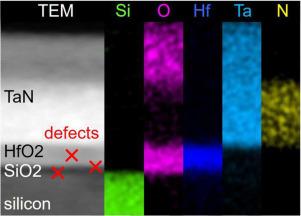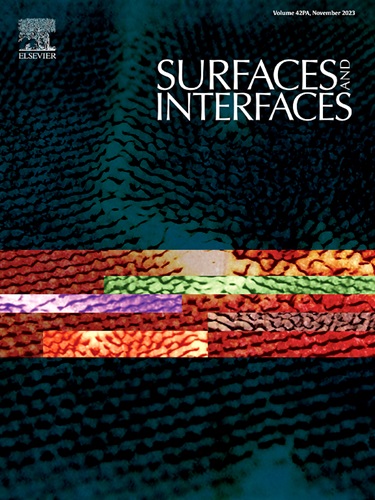SiO2/Si interface defects in HKMG stack fabrication
IF 5.7
2区 材料科学
Q2 CHEMISTRY, PHYSICAL
引用次数: 0
Abstract
The defect generation and recovery near the silicon dioxide (SiO2)/silicon (Si) interface are studied throughout high-k dielectric/metal gate (HKMG) stack fabrication and post-processing. The HKMG stack is prepared on a Si wafer in a well-established manner, using chemical oxidation for an interfacial layer of SiO2, atomic layer deposition (ALD) for HK-hafnium oxide (HfO), and magnetron sputtering for MG-tantalum nitride (TaN). The stack is then treated with additional processing of post-deposition annealing (PDA), oxygen (O) plasma processing, and forming gas annealing (FGA) to imitate transistor manufacturing. Throughout these processing, the atomic-level defects near the SiO2/Si interface are characterized, with quasi-steady-state photoconductance (QSSPC) measurements. With the measurements, it is found that the defects near the SiO2/Si interface are generated by most of the processing of ALD-HfO, sputter-TaN as well as PDA and O plasma, whereas those defects are recovered by the last step of FGA. Interestingly, the recovery of defects depends on the HKMG stack structure and processing; the recovery is highly limited for a thin stack treated with high-temperature PDA. In such a case, residual defects are created near the SiO2/Si interface.

香港半导体制造堆栈中的二氧化硅/硅界面缺陷
在整个高介电/金属栅极(HKMG)堆栈制造和后处理过程中,对二氧化硅(SiO2)/硅(Si)界面附近的缺陷产生和恢复进行了研究。HKMG 叠层是在硅晶片上以成熟的方式制备的,采用化学氧化法制备二氧化硅界面层,原子层沉积 (ALD) 法制备 HK-氧化铪 (HfO2),磁控溅射法制备 MG-氮化钽 (TaN)。然后对堆栈进行沉积后退火 (PDA)、氧气 (O2) 等离子处理和成型气体退火 (FGA) 等附加处理,以模仿晶体管的制造过程。在整个加工过程中,通过准稳态光电导(QSSPC)测量,对二氧化硅/硅界面附近的原子级缺陷进行了表征。测量结果表明,在 ALD-HfO2、溅射-TaN 以及 PDA 和 O2 等离子体的大部分加工过程中,SiO2/Si 界面附近都会产生缺陷,而这些缺陷会在 FGA 的最后一步得到恢复。有趣的是,缺陷的恢复取决于香港马会开奖结果堆栈的结构和处理过程;对于使用高温 PDA 处理的薄堆栈,缺陷的恢复非常有限。在这种情况下,会在二氧化硅/硅界面附近产生残余缺陷。
本文章由计算机程序翻译,如有差异,请以英文原文为准。
求助全文
约1分钟内获得全文
求助全文
来源期刊

Surfaces and Interfaces
Chemistry-General Chemistry
CiteScore
8.50
自引率
6.50%
发文量
753
审稿时长
35 days
期刊介绍:
The aim of the journal is to provide a respectful outlet for ''sound science'' papers in all research areas on surfaces and interfaces. We define sound science papers as papers that describe new and well-executed research, but that do not necessarily provide brand new insights or are merely a description of research results.
Surfaces and Interfaces publishes research papers in all fields of surface science which may not always find the right home on first submission to our Elsevier sister journals (Applied Surface, Surface and Coatings Technology, Thin Solid Films)
 求助内容:
求助内容: 应助结果提醒方式:
应助结果提醒方式:


